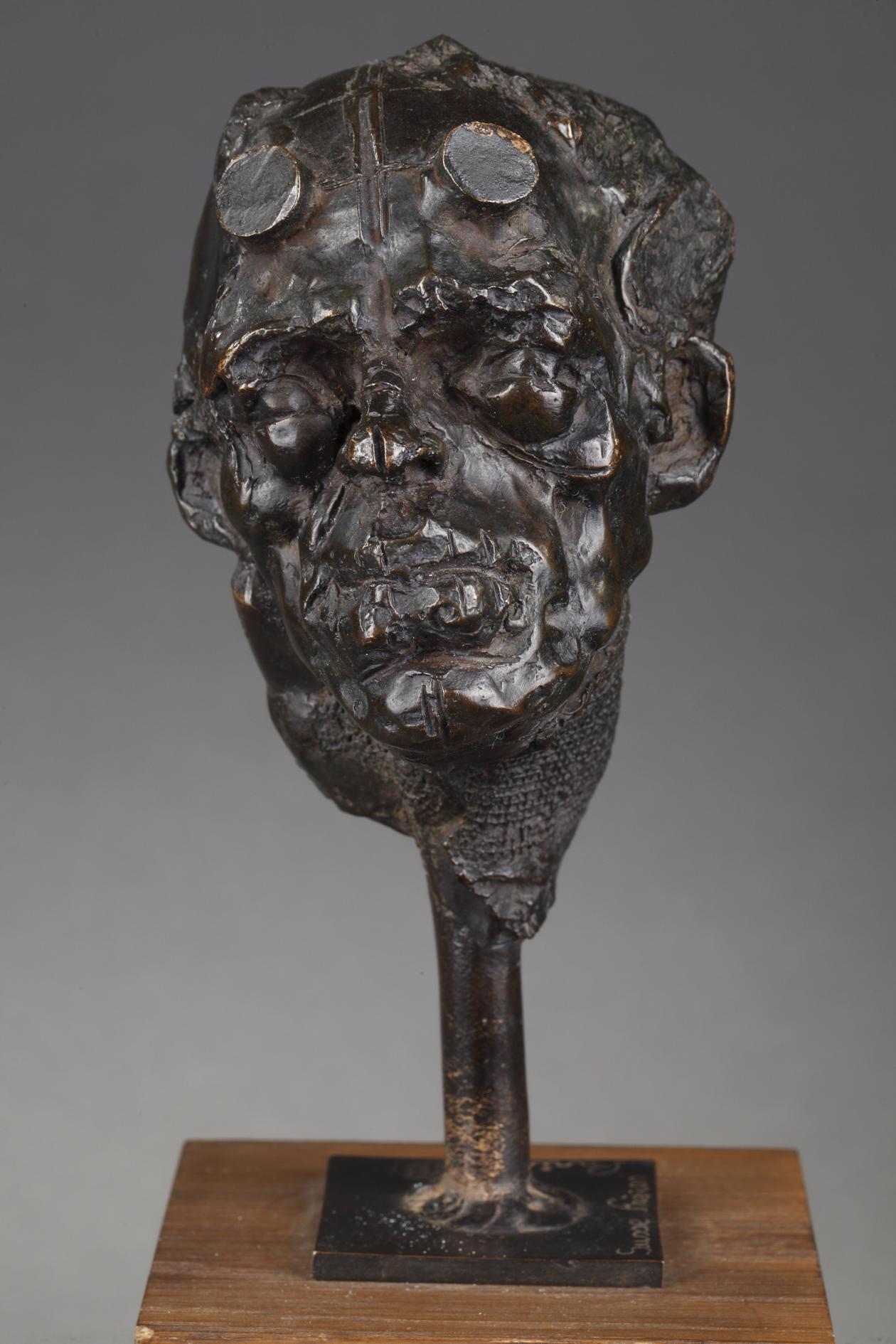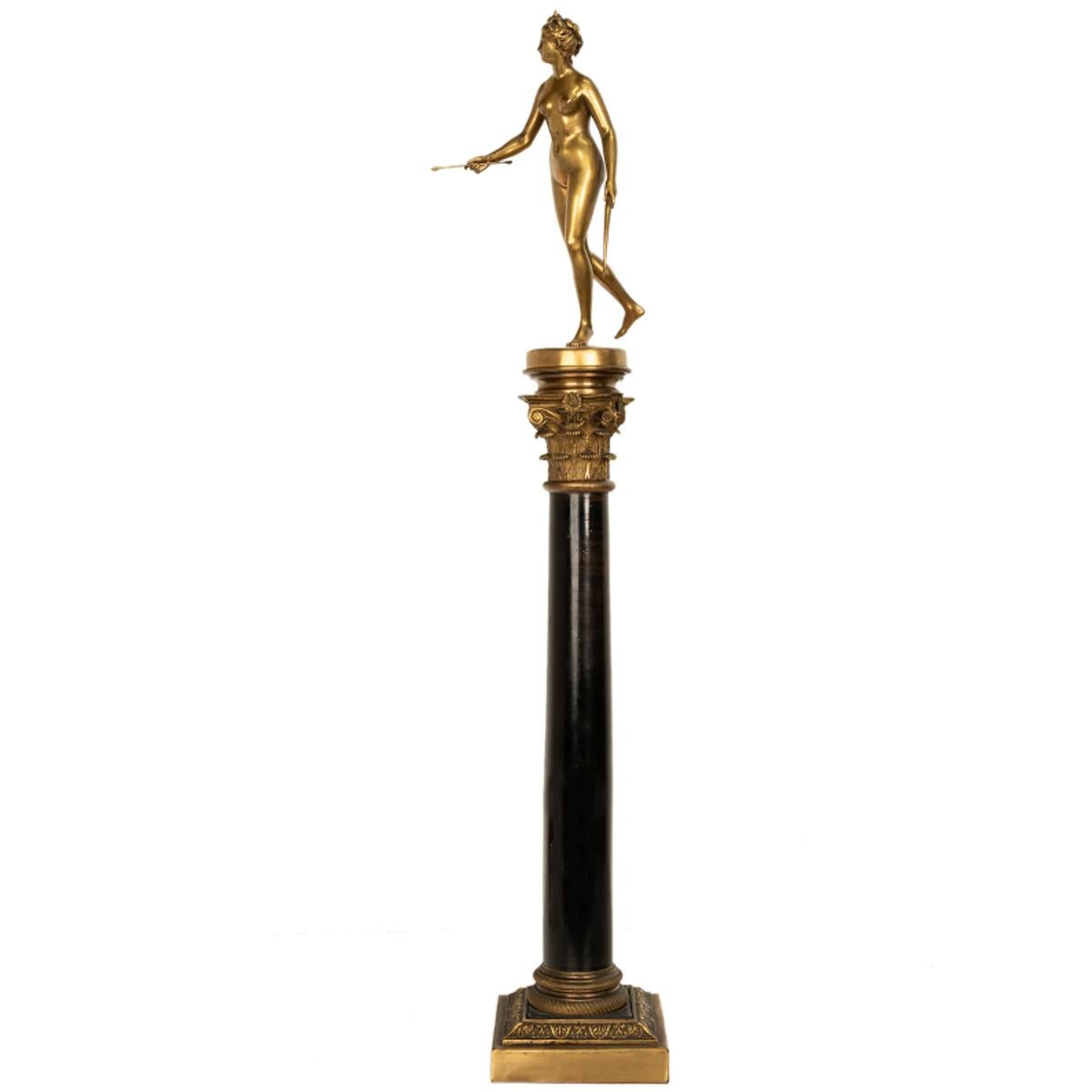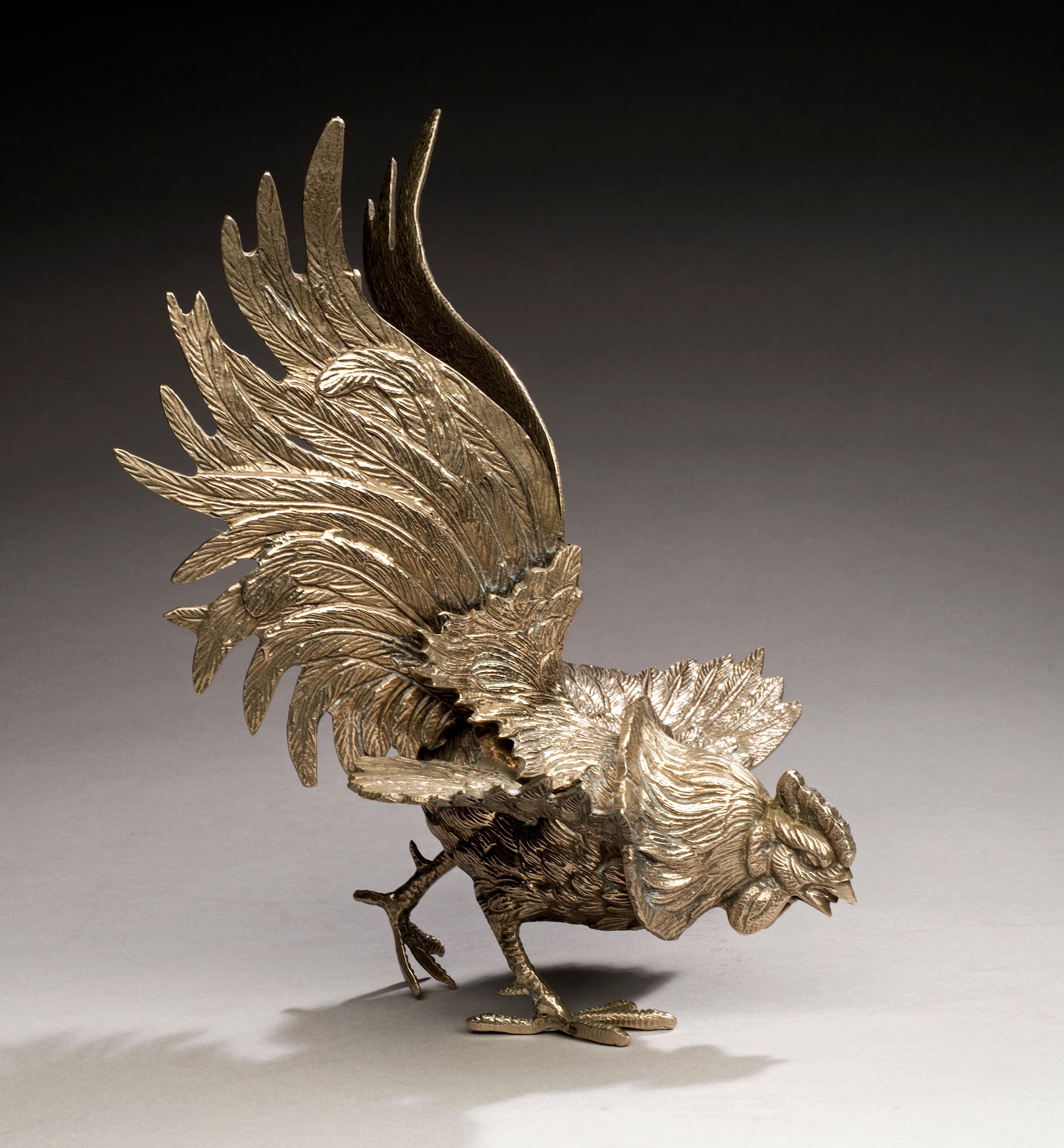Antoine-Louis BaryeReclining Doecirca 1860
circa 1860
About the Item
- Creator:Antoine-Louis Barye (1796 - 1875, French)
- Creation Year:circa 1860
- Dimensions:Height: 2.84 in (7.2 cm)Width: 4.45 in (11.3 cm)Depth: 2.09 in (5.3 cm)
- Medium:
- Movement & Style:
- Period:
- Condition:
- Gallery Location:PARIS, FR
- Reference Number:
Antoine-Louis Barye
The son of a goldsmith, Parisian born Antoine-Louis Barye was a sculptor of animal subjects and acclaimed, not only for his apparent skill but as the founder of what became known as the French Animaliers School. Among his patrons were representatives of the state government and royalty, including the Duke of Orleans and the Dukes of Luynes, Montpensier and Nemours.
Well compensated financially, Barye was able to buy the best of materials and hire the country's most skilled foundry craftsmen. The foundry he hired was owned by Ferdinand Barbedienne and casts from this period were stamped with the letters, FB. However, he did not make a lot of money from his work because he was such a perfectionist that often he would not sell his work because he thought it was not "quite right." In 1848, he declared bankruptcy and his molds and plaster casts were sold along with the copyrights.
Barye's specialty was aroused, angry-seeming wild game such as lions and tigers and elephants, but he also did equestrian groups and mythology figures. In order to do realistic depictions of animal anatomy, he spent much time at the Jardin des Plantes in Paris. His early training was as an apprentice to a metal engraver, but being drafted in the army in 1812 ended that education. In 1832, he had established his studio, and unique at that time was his method of cold stamping his bronze casts so that each one had a special number. He had his first entry, The Milo of Croton, in the Paris Salon in 1819, winning a second prize. In 1831, a work regarded as a masterpiece, Tiger Devouring a Gavial, was in the Salon and purchased for the Luxembourg Gardens, which is now in the Louvre. However, many of his subsequent Salon submissions were rejected and so angered him that between 1836 and 1851, he refused to submit entries. In 1851, he again exhibited at the Salon with Jaguar Devouring A Hare, and this work, like the 1831 entry, was placed in the Luxembourg Gardens and eventually in the Louvre.
In spite of problems with the Salon, Barye received many accolades for his work, and the period of 1837–48 was considered the most productive time of his career. However, in 1848, when he lost control of his work and it was reproduced by others including Martin and Barbedienne, the sculptures, according to some art professionals, are not as skillfully executed. In 1848, after his bankruptcy, Barye became director of Casts and Models in the Louvre, until 1850, when he was replaced by Emmanuel Fremiet. It was a very difficult time for him. However, within a few years, he began receiving accolades for the quality and uniqueness of his work, and people began appreciating the powerful images of his sculpture, especially the wildlife in their natural surroundings. In 1854, he was appointed Master of Zoological Drawing in the Musée National d'Histoire Naturelle and held this position until his death in 1875.

- ShippingRetrieving quote...Ships From: PARIS, France
- Return PolicyA return for this item may be initiated within 3 days of delivery.
- PheasantBy François PomponLocated in PARIS, FRPheasant by François Pompon (1855-1933) Exceptional bronze with old gilded patina Cast by Valsuani Period cast France circa 1930 height 8,2 cm length 14,2 cm width 3,6 cm A similar model is represented in "Pompon, Catalog raisonné", Editions Gallimard, RMN, 1995, page 202, n°95B. Biography: François Pompon (1855-1933) is known for his animal sculptures whose innovative style is characterized by the simplification of shapes and polished surfaces. Pompon entered as an apprentice in the workshop of his father, Alban Pompon (1823-1907) who was a "compagnon du devoir" of the carpenter-cabinetmakers. Thanks to a scholarship obtained by the parish priest, he left in 1870 for Dijon where he became an apprentice stonemason with a marble worker. He attended evening classes at the School of Fine Arts in Dijon, first in architecture and engraving with Célestin Nanteuil, then in sculpture with François Dameron (1835-1900). After a short stint in the army in 1875, Pompon arrived in Paris where he became a marble worker in a funeral business near the Montparnasse cemetery. He attended evening classes at the Petite École, the future National School of Decorative Arts. His teachers were the sculptors Aimé Millet (1819-1891) and Pierre Louis Rouillard (1820-1881), also professor of anatomy, who showed him the menagerie of the Jardin des Plantes. In 1890, François Pompon entered the studio of Auguste Rodin (1840-1917), where he worked as a practitioner at the marble depot, rue de l'Université. He quickly gained the master's confidence since he ran the workshop in 1893. His role then was to pass on the accounts, pay for the marbles and supervise the work. It is in this same workshop that he met Ernest Nivet and Camille Claudel. He worked for a long time as a practitioner for other sculptors such as Jean Dampt...Category
1930s French School Figurative Sculptures
MaterialsBronze
- Man's head wearing glassesLocated in PARIS, FRMan's head wearing glasses by Laurent Belloni (né En 1969) Bronze cast with a nuanced black patina Signed "Belloni" on the base Foundry mark "Susse fondeur Paris", and foundry stam...Category
1990s French School Figurative Sculptures
MaterialsBronze
- Lady with casketsLocated in PARIS, FRLady with caskets by Léo LAPORTE-BLAIRSY (1865-1923) Bronze a nuanced brown patina signed on the side of the base "Léo Laporte-Blairsy" old cast Stamped with a number "60765 / 6" F...Category
Early 20th Century French School Figurative Sculptures
MaterialsBronze
- Pair of monkey candelabrasBy Christophe FratinLocated in PARIS, FRPair of monkey candelabras by Christophe FRATIN (1801-1864) Bronze with nuanced dark brown patina signed "Fratin" on the foot old period cas...Category
Mid-19th Century French School Figurative Sculptures
MaterialsBronze
- Portrait of Albert DubarryLocated in PARIS, FRPortrait of Albert Dubarry by Léon-Ernest DRIVIER (1878-1951) Bronze with a nuanced greenish dark brown patina signed "Drivier" cast by "Montagutelli, Paris, cire perdue" (with the ...Category
1930s French School Figurative Sculptures
MaterialsBronze
- Horse training with its stable ladLocated in PARIS, FRHorse training with its stable lad by Arthur Marie Gabriel comte du Passage (1838-1909) A bronze group with nuanced dark brown patina Signed on the base " Cte du Passage " Period ca...Category
Late 19th Century French School Figurative Sculptures
MaterialsBronze
- Antique French Grand Tour Gilt Bronze Statue on Column Diana the Huntress 1838By Ferdinand BarbedienneLocated in Portland, ORA fine & large (34" tall) antique French gilt-bronze on marble column of Diana, cast by Ferdinand Barbedienne (1810-1892) after a statue by Jean Antoine Houdon (1741-1828), the bronz...Category
1830s French School Figurative Sculptures
MaterialsMarble, Bronze
- Antique Silvered Bronze Rooster, France circa 19th CenturyLocated in SANTA FE, NMAntique Silvered Bronze Rooster France, circa 1900 10 1/4 x 9 1/2 (H x D) inches A very fine and lively bronze statuette of a preening Rooster. Nicely cast and well-carved and in ex...Category
19th Century French School Figurative Sculptures
MaterialsSilver, Bronze
- Antique Bronze Dog Portrait of a Cavalier King Charles "Thigley" circa 1905Located in SANTA FE, NMAntique Bronze Dog Portrait of a Cavalier King Charles "Thigley" French School (possibly Franck Burty Haviland) Lost wax bronze casting Circa 1910 5 7/8 x 9 x 3 1/4 A sophisticated bronze casting of a Cavalier King Charles spaniel made in lost wax casting (cire perdue) from the beginning of the 20th century by Valsuani Foundry. This an unusual bronze approached in its aesthetic that’s reminiscent of the work of great animal sculptors of the second half of the 19th century except in this presentation which is more avant-garde for the time with a much looser, more impressionistic execution. The patina is a superb bronze color, brown and slightly greenish, going in places towards a more antique green. The attitude of the dog is extremely well and sensitively rendered with the placement of material unlike the renderings of a bronze by Barye...Category
Early 1900s French School Figurative Sculptures
MaterialsBronze
- RhinoBy Roland d'Andlau-HombourgLocated in Greenwich, CTBronze "Rhinoceros' by Roland d' Andlau-Hombourg (1927-2009) signed, numbered 1/6 with Godard foundry stamp R. d' Andlau was a gifted 'animalier' sculptor in the grand tradition ...Category
1950s French School Figurative Sculptures
MaterialsBronze
- Bronze Art Déco Représentant Une Oie, Les Ailes DéployéesLocated in ROUEN, FRBronze Art Déco représentant une oie, les ailes déployées. Il est à fine patine brune. Socle en marbre vert. Signé de LUC. H.31 L.21.Category
1920s French School Figurative Sculptures
MaterialsBronze
- Flora et L'amour ou HamadryadeBy Ferdinand BarbedienneLocated in Tallinn, EEFerdinand Barbedienne (1810 - 1892) Antoine Coysevox, after (France, 1640-1720) Flora et L'amour ou Hamadryade Inscribed 'A. COYSEVOX. F. 1710'. With foundry mark 'F. BARBEDIENNE...Category
Late 19th Century French School Figurative Sculptures
MaterialsBronze



